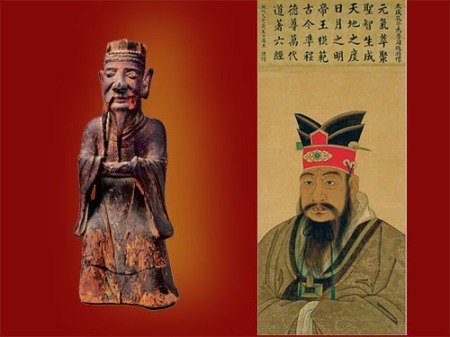By HOLLAND COTTER Published at New York Times: March 25, 2010
You be nice to me, and I’ll be nice to you. Doesn’t that sound like a smart way to run the world? The Chinese philosopher Confucius thought so some 2,500 years ago. He also believed that education, hard work and respect for the past were essential; that excessive anything — money, fun, religion — led to trouble; and that social harmony was best achieved when people interacted courteously, but basically minded their own business.
Over the centuries, depending on the prevailing political winds, Confucius has been revered in his homeland as social visionary or despised as moral despot. In the West, his name, like that of Mao Zedong, simply means “China” to most people.
He’s hard to know. Mao has a visual presence, thanks to his many portraits. But Confucius — Kong Fuzi, or Master Kong, to use one of his Chinese names — is an abstraction, which is one reason that a small, fine, get-acquainted show called “Confucius: His Life and Legacy in Art” at China Institute Gallery is so valuable. It neatly encapsulates some of the ideas that have made him a monument. But it also puts a face to his name, even if that likeness, as seen in paintings and sculptures, is fictional.
We don’t know much for sure about his life. He was born in or around 551 B.C. in the city of Qufu (pronounced chu-fu) in Shandong Province on China’s east coast. The times were fractious and volatile; his beginnings were rough. His father, probably a member of the minor aristocracy, was poor and died when Confucius was 3. His mother died when he was in his teens or early 20s, by which time he had married, produced a son and initiated a lifelong routine of dogged self-development.
Seriousness and persistence earned him a series of solid but unstimulating state jobs, leading, when he was in his 50s, to an appointment as a minister of justice. During this time he opened a private school, attracted impressive students and formulated theories about how an ideal society, based on the example of a past golden age, could be shaped from the cutthroat craziness of the world he lived in.
The ministry position, which should have been the high point of his civic career, lasted just a few months because of some political nastiness. He resigned and went into voluntary exile from Qufu. For more than a decade, he traveled the Shandong area, promoting his theories of reform and looking for a ruler who would see things his way. He never found one, and finally returned to Qufu and resumed teaching. He died there in 479 B.C.
Thanks to his students, his ideas lived on and had increasing influence. His references to older, ritually regulated societies as usable models for the present tapped into a Chinese reverence for the past. His vision of hierarchical power structures — youth honoring age, commoners honoring nobles —appealed to an imperial-minded culture. His faith in the possibility of societal harmony was deeply attractive to a people battered by feudal warfare.
By the Han dynasty (206 B.C.-A.D. 220) his authority was immense. Han emperors declared his proposal for ideal government canonical. He became an object of worship, his birthplace a pilgrimage site. A temple was built in his honor in Qufu; his Kong descendants, who continued to live in the city, were ennobled and housed in a mansion that grew to nearly 500 rooms.
For the rest of the article, please go to: http://www.nytimes.com/2010/03/26/arts/design/26confucius.html?scp=1&sq=Envisioning%20an%20Abstraction%20Who%20Was%20Also%20a%20Man%20&st=cse
Although Confucius initially escaped severe censure by Mao, in the early 1970s he became “No. 1 hooligan,” the embodiment of the hated “four olds” (old culture, old ideology, old customs and old habits), a symbol of ruling-class oppression. The Red Guards moved in on the Qufu temple with sledgehammers. The shrine’s main sculptural image of Confucius was smashed to bits.
He has since been rehabilitated. His work ethic, it seems, suits a China that has industrial pre-eminence. His disapproval of excess can be used as a warning against the corruptions of Western-style free-market glut. His concept of the evolved man as someone who deals with the world but keeps his own counsel provides a template for a China struggling to balance outreach with inward-turning nationalism.
But all that is about Confucius in the present. The exhibition evokes the past — as, in an interesting way, does China Institute itself. The gallery is and has been the most Chinese-feeling art space in the city. China has a limited number of museums based on the white-box Western model. Most are small-scale, local affairs, sometimes just a room or two attached to a temple, with display cases of historical or archaeological material.
China Institute Gallery is a kind of high-polished version of such a museum: two small rooms, each filled not quite to the overflowing. The curators of the present show — Willow Weilan Hai Chang, director of the China Institute Gallery; Lu Wensheng, director of the Shandong Provincial Museum; and Julia K. Murray, an art historian at the University of Wisconsin, Madison — have done an admirable job of installing the objects, and in presenting a big, unfamiliar subject in a comprehensible form. Bring open-minded attention to the results, and you get something like Confucian harmony in action.

